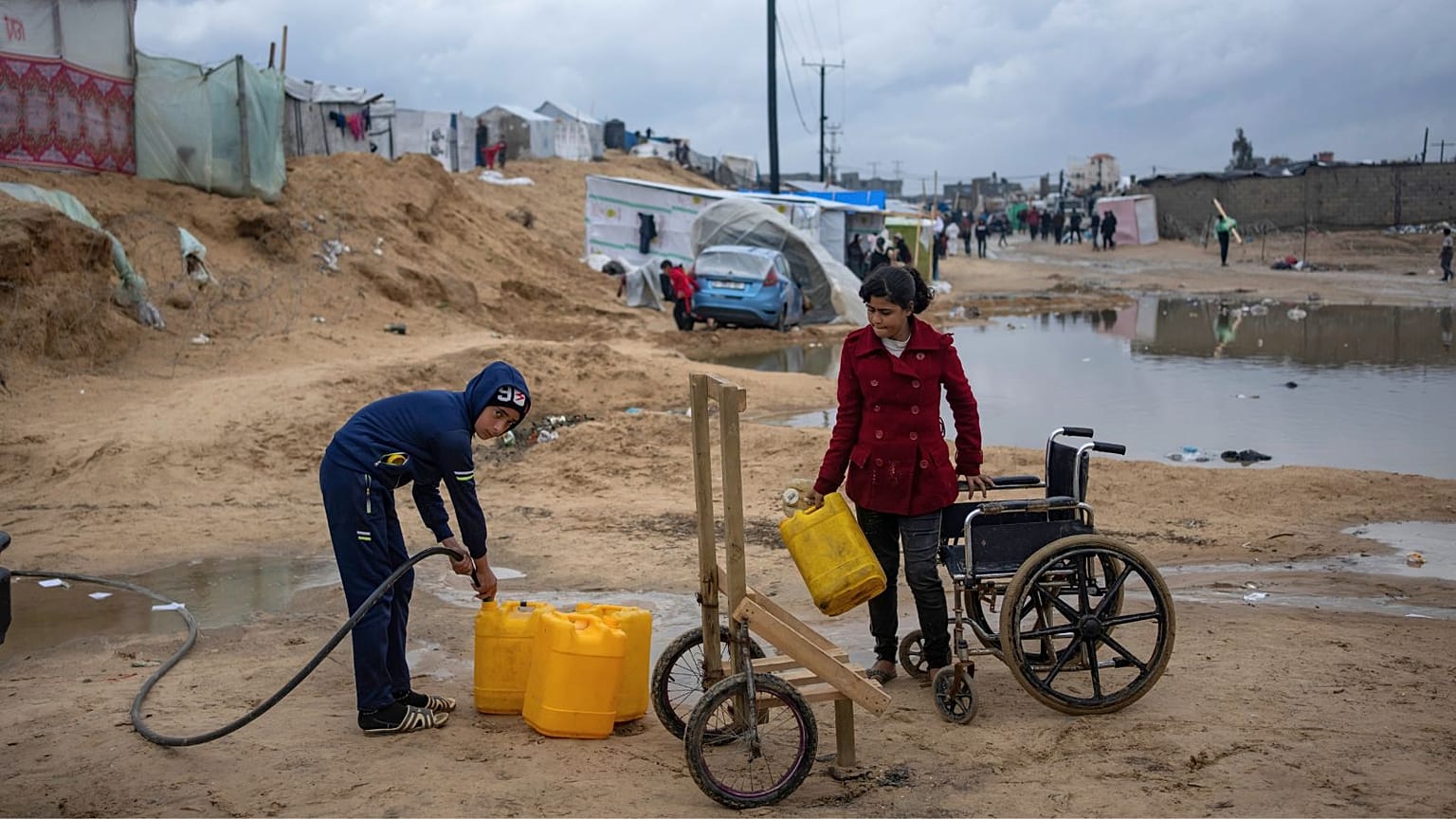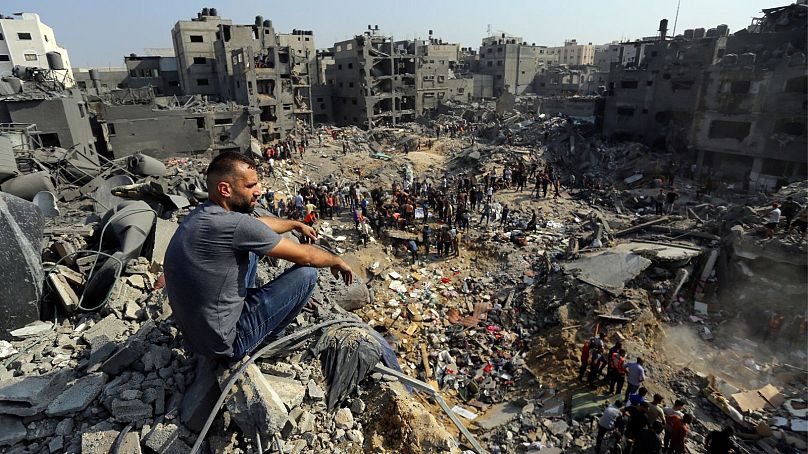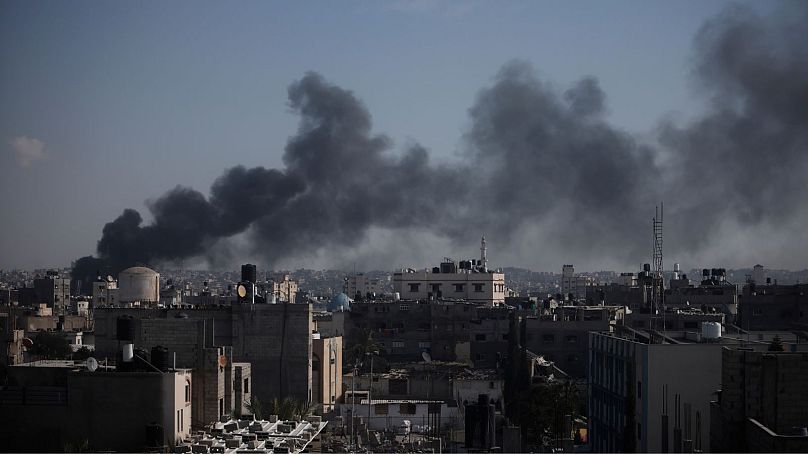Human remains, asbestos and unexploded munitions: there will be huge challenges to conducting field-based assessment work in Gaza.
The United Nations is investigating the environmental impact of the war in Gaza, which has caused a catastrophic spike in land, soil and water pollution.
It is hard to know where to begin, since the conflict has no end in sight. More than 30,000 Palestinians have been killed by relentless Israeli strikes since 7 October, when Hamas-led militants killed around 1,200 Israelis and took 250 people hostage.
Given the dangerous situation, the United Nations Environment Programme (UNEP) is not yet able to undertake field-based surveys in Gaza.
But it has accepted an official request from the State of Palestine to carry out an environmental impact assessment, UNEP’s executive director Inger Andersen revealed during a speech in late January.
Andersen reaffirmed UNEP’s commitment last week, during the sixth session of the United Nations Environment Assembly in Nairobi where she met with Dr Nisreen Al-Tamimi, Environment Quality Authority chairperson of the State of Palestine.
In recent days, devastating reports have emerged of malnourished and dehydrated babies dying in the Northern Gaza Strip. “These tragic and horrific deaths are man-made, predictable and entirely preventable,” Adele Khodr, UNICEF regional director for the Middle East and North Africa said in a statement on 3 March.
Environmental concerns pale beside such suffering. But they are also inseparable from the unfolding humanitarian disaster. Water pollution from the bombardments, for example, means a dearth in safe drinking water and a rise in water-borne diseases.
Here is what we know so far about the litany of environmental crises in Gaza, from the world’s top environmental authority.
What is the environmental impact of the war in Gaza?
“We are working with partners to gain a preliminary understanding of the extent of environmental damage,” a UNEP spokesperson tells Euronews Green. “Sources include analysis of satellite imagery, information from UN entities in the field, and knowledge of impacts from past conflicts (in Gaza and other locations).”
“All reports and data received suggest that the conflict has led to a major increase in pollution of land, soil, water - including the release of hazardous materials into the environment.”
Water pollution in Gaza
Since the escalation of the conflict in October, waste management facilities have been damaged or destroyed, and power has been cut or interrupted.
UNEP estimates that at least 100,000 cubic metres of sewage and wastewater are being dumped daily onto land or into the Mediterranean Sea.
“Historical marine pollution incidents in Gaza have led to high concentrations of chlorophyll and suspended organic matter in coastal waters, and gastrointestinal parasites: this conflict is likely increasing these issues,” the UNEP spokesperson says.
Meanwhile solid waste is being dumped in informal sites, where hazardous substances can leach into the porous soil, and potentially into the aquifer - Gaza’s main source of water.
Drinking water shortages were already a major concern for families, Save the Children says, due to the 16-year land, sea and air blockade imposed by Israel, which limited the development of water and sanitation infrastructure.
“The current crisis in Gaza is both a violent conflict, and a slow-burning eradication of children’s rights, fuelled by international neglect, a failure of leadership, and the climate crisis,” the charity’s Advocacy and Resource Mobilization Director Mohamad Al Asmar said during the COP28 climate summit in December.
“The over a million children with their lives on the line in Gaza were already on the frontline of the climate crisis. If you are a child in Gaza, you will have no memory of a life without water shortages, created by political action - the blockade - and inaction - on climate change.”
Debris pollution in Gaza
Debris and hazardous waste are also a major concern, says UNEP.
As of 7 January, the organisation estimated that the total quantity of debris amounted to 22.9 million tonnes - a figure that will have increased significantly in the weeks since.
“This is an extremely large amount of debris, especially for such a small area,” the spokesperson says. “Managing the debris will be an extensive and sensitive operation.”
“The rubble itself constitutes a physical barrier and may lead to injuries; and components of the debris and rubble can contain harmful substances like asbestos, heavy metals, fire contaminants, unexploded ordnance, and hazardous chemicals.
“Human remains are under the building debris, so sensitive management will be critical.”
Air pollution in Gaza
On top of solid waste poisoning Palestinians’ soil and water, UNEP outlines the dangers of solid waste burning in open fires - which releases a range of hazardous gases and particulate pollutants into the air.
“Looking ahead,” the UNEP spokesperson concludes, “it will be important to investigate other conflict-related sources of contamination, including from munitions debris, by products of the use of munitions and subsequent fires, unexploded ordnance and possible further degradation and contamination of land and groundwater.”
People in Gaza will not be the only ones to suffer from this rise in air pollution. 281,000 tonnes of planet-warming gases were released in the first 60 days of the war, according to analysis by UK and US researchers released earlier this year.
That’s equivalent to burning at least 150,000 tonnes of coal; with 99 per cent of the pollution attributable to Israel’s aerial bombardment and ground invasion of Gaza.
What is the scope of UNEP’s environmental assessments?
Environmental assessments are a “well-established” part of UNEP’s work, Andersen explained in January, pointing to recent precedents in Ukraine.
“The goal of such assessments is always to track the extent of damage and inform a science-based approach to recovery and reconstruction, when conditions allow,” she said.
“An approach that minimises the long-term impact on the environment and mitigates the harm caused, to the greatest extent possible. But to assess and recover, conflicts must end, so I echo the Secretary-General’s call for an end to hostilities.”
In October 2023, UNEP published a rapid environmental assessment of the Kakhovka Dam breach - which Ukraine says was destroyed by Russia - at the request of the Ukrainian government. Leveraging official data, satellite imagery and remote sensing, the report concluded that the consequences will be felt for decades, far beyond the country’s borders.
The authors stopped short of apportioning blame exactly, but called the dam’s destruction “the most significant individual cause of environmental damage in the Russian Federation’s war on Ukraine to date” - as part of a wider context in which the environment is a “silent victim”.
UNEP previously published a story entitled ‘the toxic legacy of the Ukraine war’ in February 2023; and prior to that a preliminary review of the environmental impact in October 2022.
Ukraine has repeatedly said that it is counting the environmental cost of Russia’s full-scale invasion in order to hold its enemy morally and financially accountable for ecocide post-war.
Is Palestine counting the cost of war in Gaza?
Following their meeting at UNEA-6 in Kenya, a statement from the Palestinian Environmental Quality Authority (PEQA) said Dr Al-Tamimi “praised the efforts” of Andersen, and welcomed UNEP’s quick response to the issue in working on a ‘preliminary report’.
“This response was considered an important step and the preparation of the initial report is a prelude to a deeper study of the environmental impacts of the war after the entry of technical teams to the Strip, and to highlight the urgent need to protect the environment in light of the difficult conditions that our people are experiencing in the Gaza Strip,” PEQA added.
In her speech, Dr Al-Tamimi “stressed the need to support the conduct of this report comprehensively and urgently, and to dispatch the necessary teams to investigate possible environmental crimes in the Gaza Strip.”
PEQA’s social media accounts share updates on some of these potential crimes, from Israel’s use of white phosphorus, to the destruction of solar energy facilities.
The authority did not immediately respond to a request for comment.




















